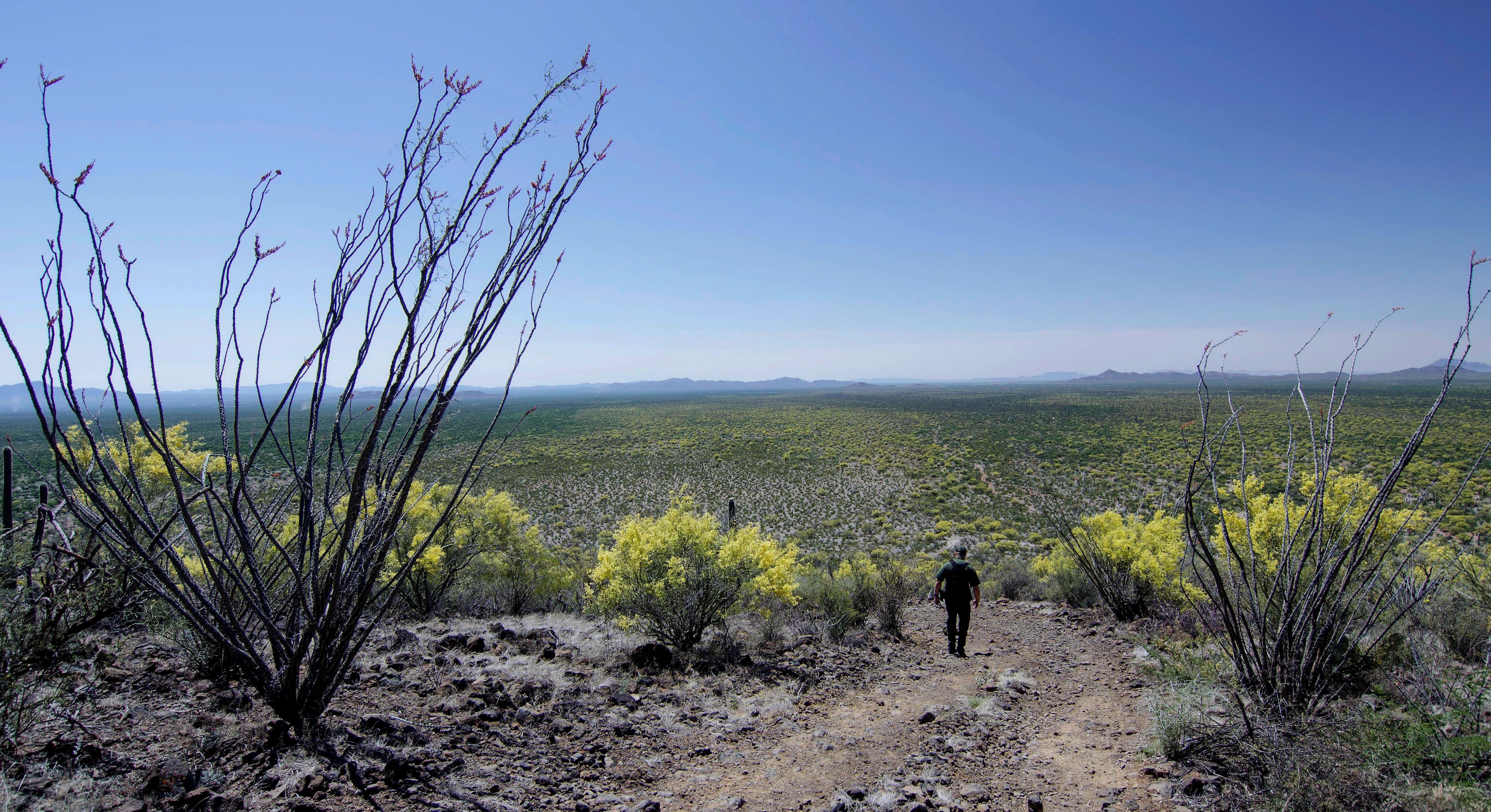
Further Reflection
Arizona’s border region north of Mexico is mostly a desert basin interrupted by clusters of rugged mountains, a challenging environment for Border Patrol agents who work to secure it.
For most of the past century, agents patrolled these dusty hills and valleys mostly on their own, relying on personal knowledge, experience, instincts, guts and luck as they pursued answers to this vast territory’s challenges and mysteries. Who made those footprints in the sand? Was it a hopelessly lost family in need of help or a gang of armed and desperate drug smugglers? What just caused the brush to crackle, an animal or a person?
"We usually had to do our jobs without a lot of information," said Operations Officer Joseph A. Korchmaros, who has long patrolled this area where he was born and raised. "There was no sure way of knowing when, where or who we would encounter next, and no awareness of the degree of threat. The environment we worked in was a lot like operating in a dark room."
In recent years, Customs and Border Protection has been deploying an array of tools and technologies the Border Patrol believes is helping to solve its most difficult challenges. The most recent innovation, linking advanced cameras to high powered radar, is providing a new awareness of threats in this vast territory.
"This new surveillance technology has basically thrown a switch and turned the lights on for us," Korchmaros said. “It changes our working environment dramatically, makes us more effective and efficient and allows us to operate more safely.”
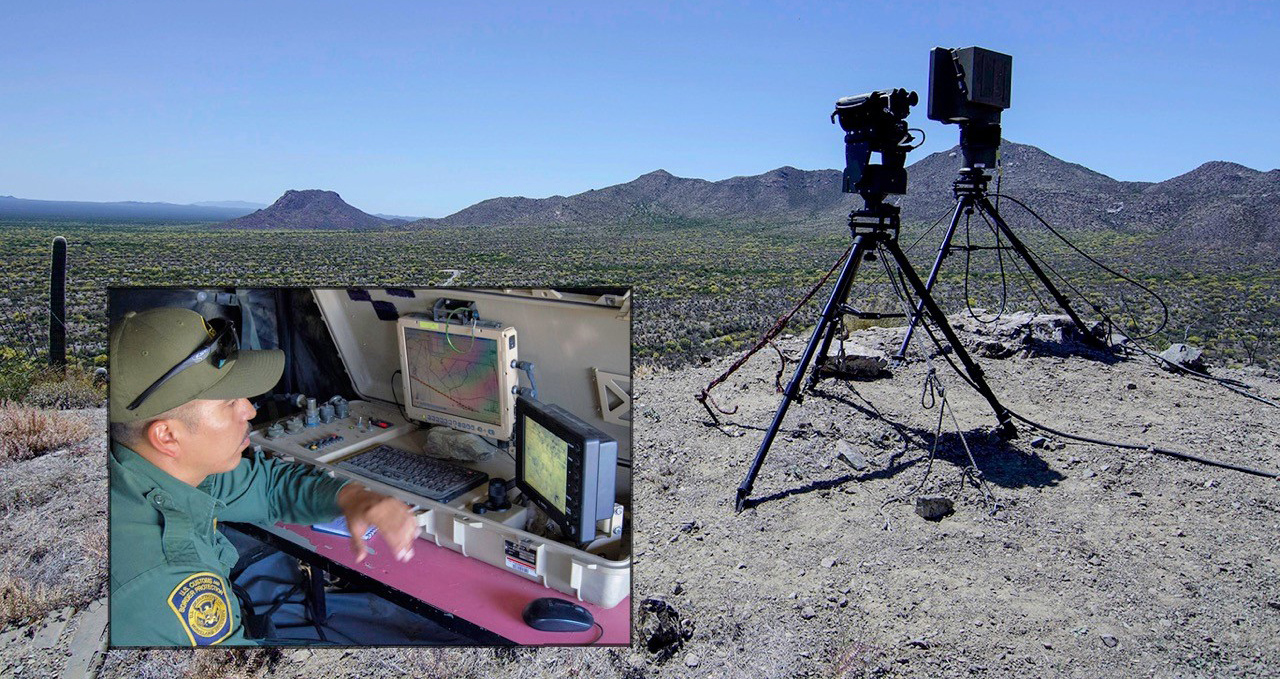
Nearly a decade ago the Border Patrol established a three-pronged strategy for better securing U.S. borders: hiring more highly skilled agents, building and maintaining better fences, barriers and access roads, and deploying specialized technologies that help agents monitor their turf.
The result has been appropriations that doubled the number of agents and built an extensive network of border fencing, vehicle barriers and access roads. But the third goal took more trial and error, more testing and evaluation. This deliberate approach went forward under the umbrella of the Arizona Technology Plan, which considered an array of tools for the Tucson sector.
Border Patrol, assisted by CBP’s Office of Technology Innovation and Acquisition, is in the final stages of implementing the plan. The project has or soon will add to valuable technology, such as sensors and night vision goggles. The plan also enhances and expands the use of video surveillance.
“The true innovation with this technology effort was to access aviation surveillance technologies that combined radar and long-distance cameras and adapt them for border security use,” said Supervisory Border Patrol Agent Dustin Roll. “That’s been the solution for us that has added the most flexibility and effectiveness.”
Radars track movement. Cameras allow agents to “see” what caused that movement. Combining the two allows a small team of agents to monitor vast and varied stretches of border area from a variety of viewpoints. It also allows agent monitors to provide critical information to agents on the ground: How many individuals? Do they appear to be smuggling drugs? Is anyone armed?
And, importantly, it allows the flexibility to provide an array of solutions adaptable to a given location. This is not an expensive breakthrough invention, but rather the adaption of proven surveillance products for border uses. Depending on the specific challenge, this can range from 120-foot-high towers or similar radar and camera equipment scaled down for mobility by a few agents.
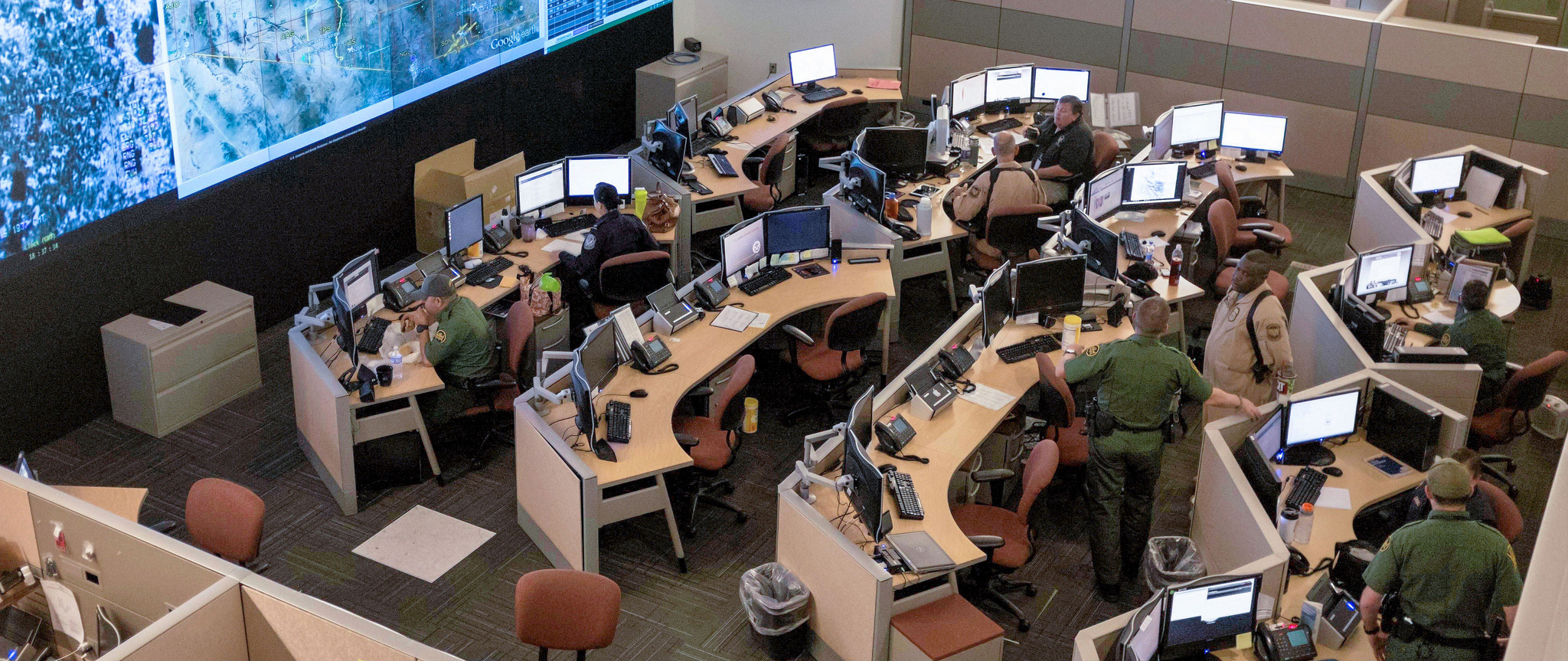
“We have yet to discover that one piece of technology that is a one-size-fits-all solution,” said Division Chief Raleigh Leonard. More effective for the Border Patrol is the opportunity to locate towers strategically and to supplement them with more mobile and portable systems. Surveillance equipment does not see through mountains, so different site angles help complete the picture.
In the relatively urban border area of Nogales, high definition cameras focus on the 20-foot barrier that separates the Mexican and U.S. sides of the border. The cameras display movement to agents in the Border Patrol’s command and control center. So when a young man managed to climb the fence from Mexico, and used a rope to almost instantly rappel down into the U.S., he landed on his feet and was running off to a neighborhood in just seconds. But he ran straight into agents who intercepted him thanks to the information the agents received from the command center.
Higher above Nogales, forming a bit of an arc around the city, are remote towers that provide an enhanced view of the area. These video surveillance systems have been in operation for years, proving to be invaluable in securing Nogales. As part of the Arizona technology plan, these towers are being upgraded to improve accuracy, reliability and communications to the command center.
These cameras and towers are being supplemented by suitcase-based camera and radar equipment agents transport to key vantage points. Rugged vehicles with telescoping surveillance equipment also can be driven to a location and deployed for up to a week. The “control room” for agents is in the back seat of the truck’s cab. The passenger seat has been flipped around to give access to monitors for the radar system and camera as well as to a keyboard and mouse or track pad.
The final arc beyond those tools are the newest Nogales towers with the most precise radar and cameras, providing the longest reach and highest level of communications. These towers are located in the high ground of the rolling hills east and west of the city. These Integrated Fixed Towers are in testing now, and could become fully functional in July. Many more could then be deployed throughout southern Arizona in coming years, shining a light on the entire region.
These new fixed towers, powered by solar panels and providing instantaneous integration of images and alerts to the control center, help close the final gaps for those trying a challenging end-around over and through the roughest terrain.
As one agent was being trained on the new systems and was seeing the visual feeds at the Nogales command and control center in late April, he recognized the potential of what he was seeing. “Game changer,” the agent predicted.
In many respects the border security challenge has already changed. There was a time when agents along the entire Mexican border arrested undocumented immigrants as often and as fast as they could, and many more walked past them. In 2000, 1.6 million apprehensions were made along the Mexican border, and that followed 17 years of averaging more than a million apprehensions a year.
It may seem counterintuitive, but high apprehension numbers are evidence of a border out of control, where there are few barriers, real or perceived, to entry into the U.S. High apprehensions are seen as evidence of low deterrents to violate U.S. law.
As more agents, better infrastructure and more powerful technology take hold, the downward trend has been dramatic. Apprehensions have dropped by more than two-thirds on the California, Arizona, New Mexico and Texas border, and in the Tucson sector they are down from more than 616,000 in 2000 to just under 88,000 last fiscal year. That’s a drop of more than 85 percent.
"The word's gotten out that it's now harder than it used to be to cross our southern border," Homeland Security Secretary Jeh Johnson told the Los Angeles Times April 25, specifying that unmanned aircraft, sensors, fencing and more agents have shown results.
"Surveillance technology is the wave of the future," Johnson said, noting he intended to take steps to expand the program.
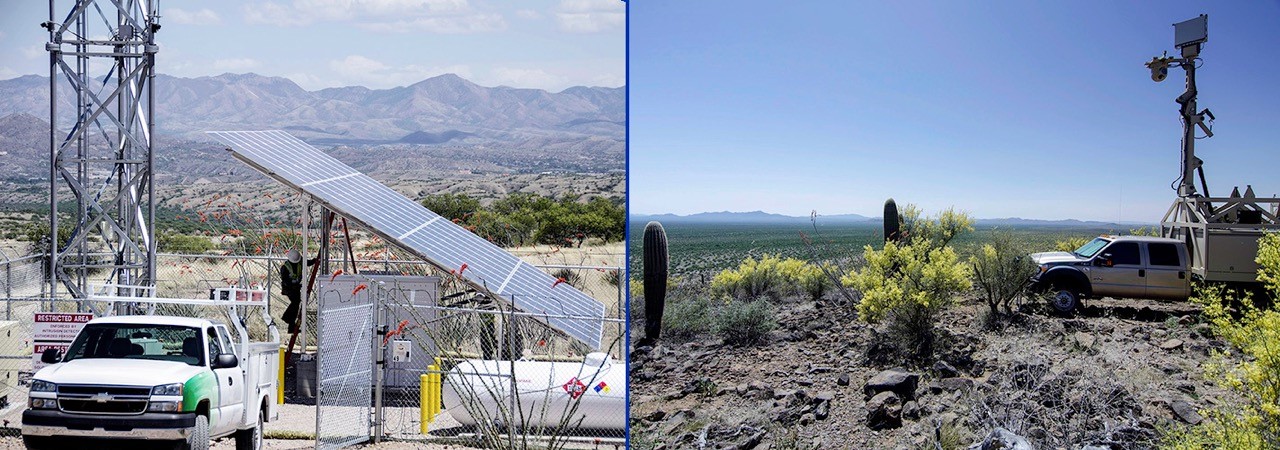
In Border Patrol vernacular, surveillance technology is providing “situational awareness.” This means that agents can detect, identify, classify, respond and resolve any indication of potential illegal activity at or near the border. This may sound bureaucratic, but it is meaningful, even personal, to agents in Arizona.
Their job can be extremely dangerous and close-knit agents often reflect back on tragedies that cost the lives of fellow agents. Surveillance technology holds promise of lessening the dangers agents face. Those agents working on the technology upgrades mention that one of the positive impacts of improved situational awareness is greater officer safety.
Another favorite Border Patrol phrase is “force multiplier,” a designation for any capability that increases the effectiveness of agents in the field. So the enthusiasm for the Arizona technology efforts is related to innovations that enable agents to do more while relieving them from time consuming and often fruitless work they had been doing.
“Before the deployment of the advanced technologies, agents could literally spend hours, if not shifts or days, tracking illegal border crossers or narcotics traffickers,” Leonard said. “Now time on task has been significantly reduced. With the benefit of these surveillance tools, an interdiction now typically takes an hour or less, when in the past it would take up to 8-10 hours.”
The result is that agents are spending less time tracking and watching and more time on other law enforcement activities.
“The increase in technology, infrastructure and personnel in the Tucson Sector has translated into fewer indications of a chaotic border environment,” Leonard said. “We are seeing a safer border environment, with far less activity related to narcotic trafficking and migrant crossings. I believe this can be attributed to hard-working agents supported by advanced detection technology and also supported by collaboration from a multitude of other agencies.”
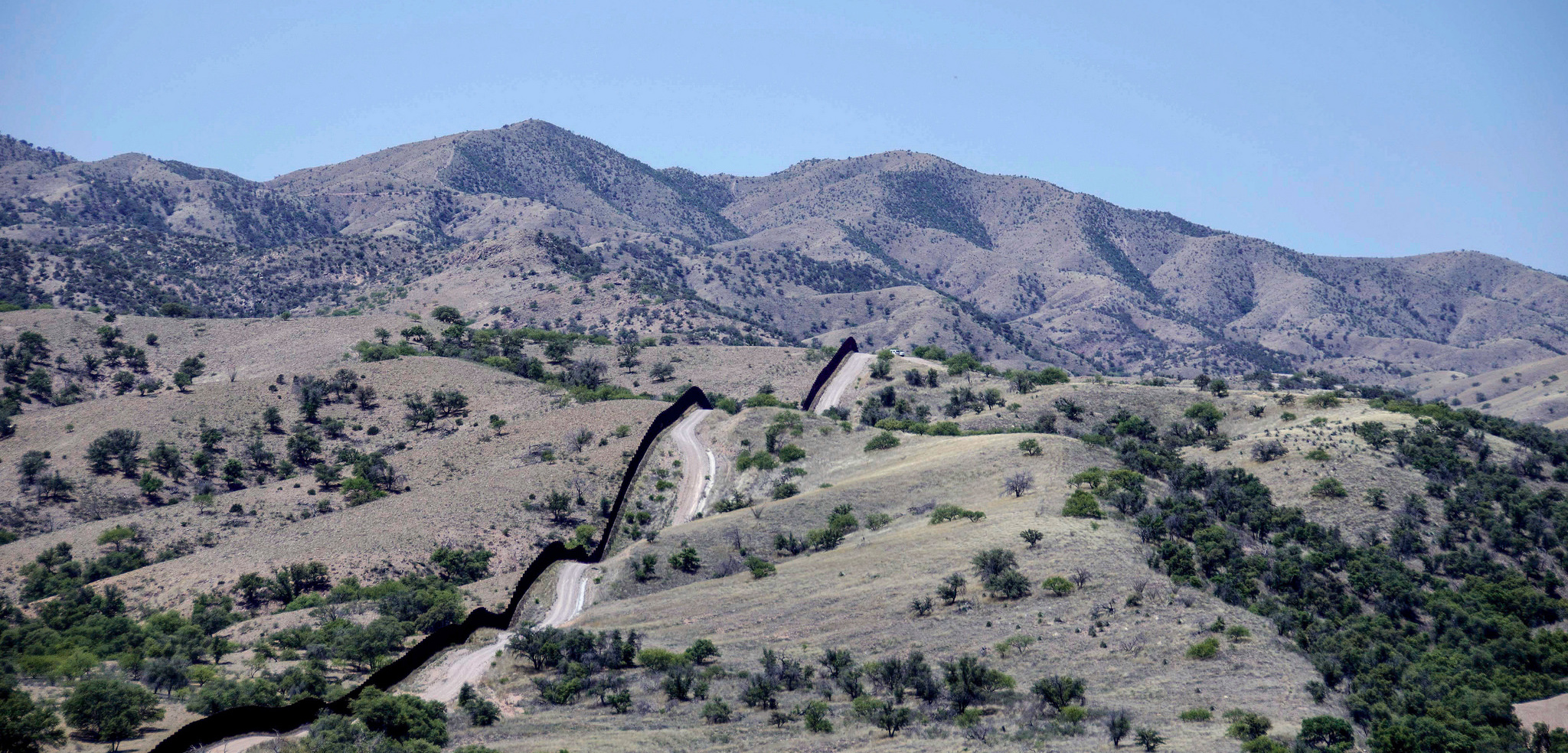
The realization of the Arizona Technology Plan is seen as a beginning rather than an end. Border security, which largely pits agents versus highly motivated, sophisticated and adaptive smuggling cartels, has been marked by reactionary steps by both sides.
Success in one area deflects illegal activity elsewhere. Successes in Arizona have given way to increased challenges in Texas, especially in the Rio Grande Valley. There is no doubt that some of the lessons learned and tools deployed in Arizona can play a key role in West Texas and elsewhere, despite its different physical environment.
There are other tools and refinements on the Border Patrol wish list. Reduced size and greater mobility of the equipment would allow agents to quickly adapt to changing patterns.
“I see the future of technology, based upon what we are seeing in Tucson, is greater integration,” Leonard said. “You wouldn’t have stand-alone technology solutions, they would all be beamed into a command and control center where one agent or a small team of agents could monitor a large geographic area of the border.”
And Leonard believes that this technology can also be adapted to better safeguard agents through what is termed “blue force tracking,” where agents and their vehicles would have a device that would allow the command center to know where they are at all times, and would help agents know where other agents are in the area.
“Besides great agent safety, I believe this would allow us to become much more efficient, much more effective in vectoring in agents to our targets of interest,” Leonard said.
And deeper into the future, Leonard said, he hopes that facial recognition technology can be adapted for border use to allow faster determination of threat levels. Knowing an individual in a remote area is a landowner can save time, but more critical would be to make an early determination that the camera is seeing a known smuggler with a violent criminal record. This would help determine how best to respond and better safeguard agents.
“Our success continues to be determined by the brave and resourceful actions of our agents,” Leonard said. “But the better tools and the more information we give them, the more successful they will be and the safer our communities will be.”


